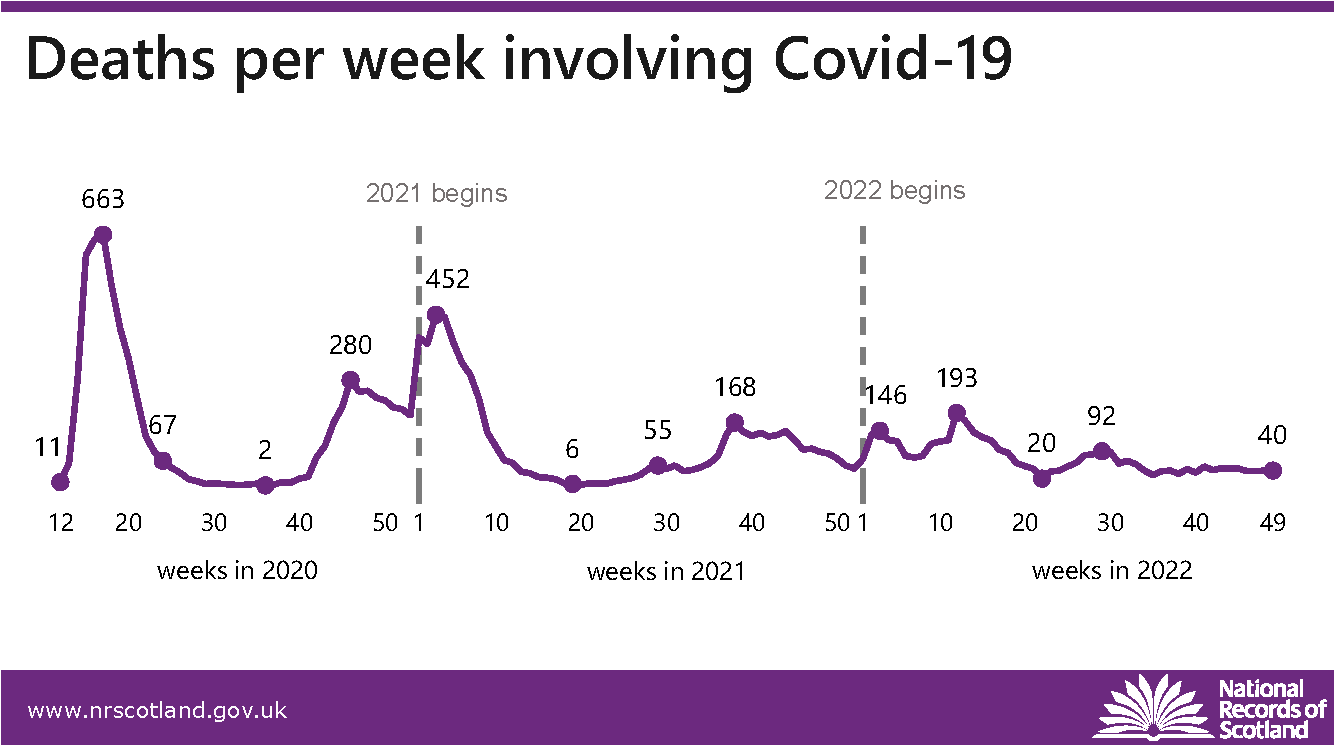As at 11 December 2022, 16,213 deaths have been registered in Scotland where the novel coronavirus (COVID-19) was mentioned on the death certificate, according to statistics published today by National Records of Scotland (NRS).
In the latest week, 40 deaths were registered that mentioned COVID-19 on the death certificate, one fewer than in the previous week.
There were five deaths in City of Edinburgh, and three deaths in each of Dundee City, East Dunbartonshire, Glasgow City, Highland, and North Lanarkshire. In total, 21 council areas (out of 32) had at least one death involving COVID-19 last week.
31 were in hospitals, six were in care homes, and three were at home or a non-institutional setting. 21 deaths were female and 19 were male. 28 were aged 75 or older, 10 were aged 65 to 74 and 2 were under 65.
Our monthly analysis shows that the age standardised death rate for deaths involving COVID-19 was similar in November 2022 (40 per 100,000) compared to October 2022 (41 per 100,000). Throughout the pandemic, the highest rate of COVID-related deaths was 585 per 100,000 people in April 2020.
Of the 16,180 deaths involving COVID-19 between March 2020 and November 2022, 93% (15,119) had at least one pre-existing condition, with the most common being dementia or Alzheimer’s disease.
Pete Whitehouse, Director of Statistical Services, said:
“The latest figures show that last week there were 40 deaths where COVID-19 was mentioned on the death certificate. This is one fewer than in the previous week.
“People living in the most deprived areas were 2.4 times as likely to die with COVID-19 as those in the least deprived areas. The size of this gap slowly widened over the period of the pandemic but has narrowed since January 2022, when the gap was 2.5.
“The number of deaths from all causes registered in Scotland in this week was 1,287, which is 100, or 8%, more than the five year average.”
There have been nine deaths in Scotland in which the underlying cause of death was due to the adverse effects of vaccination against COVID-19, and four further deaths where an adverse effect was mentioned on the death certificate. This is no change from the figure reported last month. By 30 November 2022, statistics from Public Health Scotland state that 4.4 million people had been given at least one vaccine dose.
The publication Deaths involving coronavirus (COVID-19) in Scotland is available on the NRS website.

Background
We update the weekly COVID-19 death information in our data and charts spreadsheet and publish a full report and news release on a monthly basis.
NRS figures include deaths where ‘suspected’ or ‘probable’ COVID-19 appears on the death certificate.
Data are provisional and subject to change in future weekly publications. The 2022 data will be finalised in summer 2023.
Media enquiries should be directed to:
Donna Green
NRS Communications
Tel: 07775-027-380
Email: [email protected]
Further information about the statistics is available from:
NRS Customer Services
Email: [email protected]